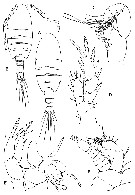|
|
 |
|
Calanoida ( Order ) |
|
|
|
Pseudocyclopoidea ( Superfamily ) |
|
|
| |
| | | |
| Boholinidae Fosshagen & Iliffe, 1989 ( Pseudocyclopoidea ) | | Syn.: | Boholiniidae Fosshagen & Iliffe, 1989, emend. Huys & Boxshall,1991 | | Ref.: | Fosshagen & Iliffe, 1989 (p.201, 207); Cuoc & al., 1997 (p.651, Fig.6: evolutionary trend); Huys & Boxshall, 1991 (p.419, 461); Bradford-Grieve, 1999 b (p.22, Def.); Ohtsuka & Huys, 2001 (p.461); Boxshall & Halsey, 2004 (p.13; 49; 75: Def., spp. Key); Bradford-Grieve & al., 2014 (p.507, 526, Rem).
Bradford-Grieve J.M., (2002 onwards). Key to calanoid copepod families. Version 1 : 2 oct 2002. http://www.crustacea.net/crustace/calanoida/index.htm  | | Rem.: | This family shows kinship with the Ridgewayiidae and the Pseudocyclopidae. She is represented by only one genus and two species, found in a brackish cave in the Philippines.
Type-genus: Boholina Fosshagen in Fosshagen & Iliffe, 1999. Total: 1 G..
For Bradford-Grieve & al. ( 2014, p.507, 526) the family is a synonym of Pseudocyclopidae.
Taxonomic notes after Boxshall & Halsey (2004, p.75): Very primitive family of calanoids combining the retention of paired genital apertures in the female with the derived state of the antenna (A2) in which the distal endopodal segment is a bilobed compound segment. The retention of the inner coxal seta on the female P5 is also a rare plesiomorphic condition in the Calanoida. |  Issued from : G.A. Boxshall & S.H. Halsey in An Introduction to Copepod Diversity. The Ray Society, 2004, No 166, Part. I. [p.75]. Armature formula of swimming legs P1 to P4 and P5 (f) female. Nota: Female P5 comprising 2-segmented protopod, 2-segmented endopod and 3-segmented exopod. - Male P5 asymmetrical joined by fusion of coxae and intercoxal sclerite; right leg with large basis bearing outer seta on posterior surface; exopod 1-segmented armed with 2 lateral and 2 distal spines; lobate, unsegmented endopod bearing 2 reduced setae. Left leg with large basis bearing outer seta, endopod lobate, unsegmented and unarmed; exopod 3-segmented, forming grasping organ , 1st and 2nd segments each with outer spine, 3rd segment produced with complex array of curvede processes. - Eggs presumably released into water. |
 Issued from : G.A. Boxshall & S.H. Halsey in An Introduction to Copepod Diversity. The Ray Society, 2004, No 166, Part. I. [p.77, Fig. 9]. Boholinidae. A, Boholina crassicephala habitus female (dorsal); B, habitus male (dorsal); C, female Mxp; D, P5; E, male P5, left exopod somewhat twisted; F, female A2. [Fosshagen & Iliffe, 1989]. | | | | | (1) Boholina Fosshagen, 1989 | |
| | Ref.: | Fosshagen & Iliffe, 1989 (p.201); Huys & Boxshall, 1991 (p.461); Razouls, 1993 (p.306); Cuoc & al., 1997 (p.651, Fig.6: female genital area); Mauchline, 1998 (p.70: F; p.73: M); Boxshall & Halsey, 2004 (p.76: spp. Key); Boxshall & Jaume, 2012 (p.53: Rem., p.57: Spp Keys). | | Rem.: | type: Boholina crassicephala Fosshagen in Fosshagen & Iliffe, 1989. Total: 2 spp.
Diagnosis from Bradford-Grieve (1999 b, p.22): After Fosshagen & Iliffe, 1989:
- Head and pediger segment 1 separate, pediger segments 4 and 5 fused.
- Rostrum down-turned and rounded at its tip.
- Urosome 3-segmented in female [in reality 4], and 4-segmented in male [in reality 5, see in remarks].
- Female genital openings widely separated.
- Caudal rami produced into a pointed process distally.
- A1 25-segmented, segments 8 and 9 partly fused.
- A2 exopod distinctly 8-segmented.
- Endopod of P1 3-segmented, each segment with a pointed outer distal corner, last segment without any outer seta and with a strong subapical spine.
- P4 with slightly modified terminal spines on exopod.
- P5 male is a complex grasping organ with highly modified exopods and reduced 1-segmented endopods.
After Boxshall & Jaume (2012, p.53) the genus were established by Fosshagen & Ilille (1989) on the basis of two new species discovered in a brackish pool in San Vincente Cave on Bohol Island (Philippines). In the original description, the urosome of the females and males were described as 3- and 4-segmented respectively. It is shown that the anal somite has been overlooked in both sexes and this has been verified by examination of the types of B. crassicephala. It is represented by a short hoop of cuticle, which lies more-or-less completely telescoped within the preceding free abdominal somite. The presence of the extensive hyaline membrane around the entire posterior margin of that somite adds to the concealment. A similarly tiny and concealed anal somite was noted for genera such as Edaxiella, Oinella and Gloinella within the closely related Epacteriscidae.
For the authors it is interesting to note that Boholina tends to occur in cave poole.
Key to species after Boxshall & Halsey (2004, p.76) :
1 - A1 reaching slightly beyond 3rd pedigerous somite in female; frontal margin of dorsal cephalic shield with transverse crest; right exopod of male P5 with 4 strong, serrate spines ......Boholina crassicephala
1' - A1 reaching to muddle of genital double-somite in female; dorsal cephalic shield without frontal crest; right exopod of male P5 with 3 strong spines and 1 small spine ...... Boholina purgata. | | Remarks on dimensions and sex ratio: | | The mean female size is 0.780 mm (n = 4; SD = 0.053), and in male 0.710 mm (n = 0.0548). The size ratio (Male: female) is 0.910. The sex ratio is 1. | | |
|
|
 Any use of this site for a publication will be mentioned with the following reference : Any use of this site for a publication will be mentioned with the following reference :
Razouls C., Desreumaux N., Kouwenberg J. and de Bovée F., 2005-2026. - Biodiversity of Marine Planktonic Copepods (morphology, geographical distribution and biological data). Sorbonne University, CNRS. Available at http://copepodes.obs-banyuls.fr/en [Accessed January 06, 2026] © copyright 2005-2026 Sorbonne University, CNRS
|
|
 |
 |




